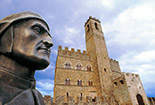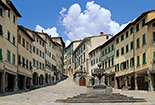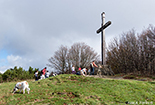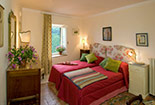Porciano, a place overlooking
the Casentino, a Tuscan valley with which you can get familiar in every detail through this site
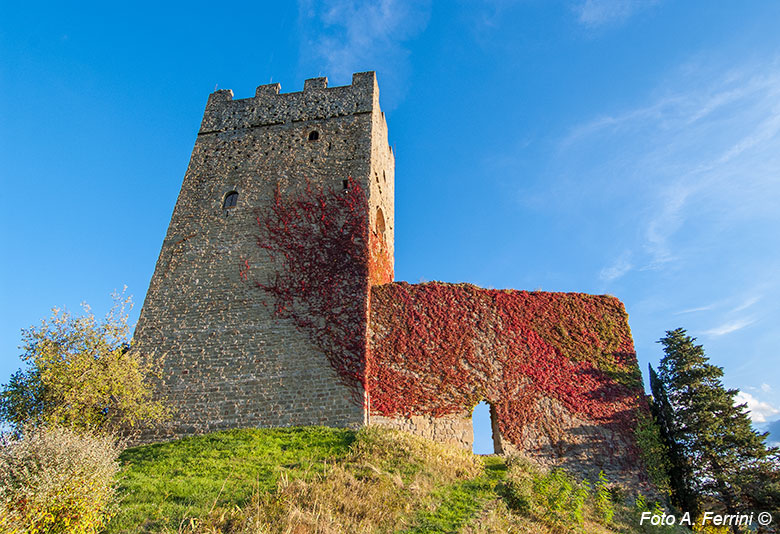
Texts and photos by Alessandro Ferrini ©
30 images in sequence to get to know the Porciano Castle and the landscape that surrounds it. Click to enlarge
Porciano Castle: a terrace overlooking the Casentino
 Arriving in the highest part of the Casentino from the south, i.e. going up the course of the Arno, it is impossible that our attention is not attracted to a small village on the slopes of the mountain that descends towards Stia (Monte Falterona) characterized by the presence of a large tower . It is Porciano, a place known for its ancient castle, the first founded by the Guidi (the nearby Castle of Romena, a few years older, was founded by the Lordship of Spoleto).
To reach Porciano from Stia, take the road that heads to Mugello, the valley of the Sieve river. After a few hundred meters, a detour to the right leads to the castle in about a kilometer. Once in Porciano, it is clear to us why the Guidi Counts built a sumptuous castle in this place at the beginning of the 11th century. From here it dominates the Arno valley up to Bibbiena, the Castle of Romena is in front of us, on the opposite hill. Poppi Castle, even if further away, is clearly visible. This, however, was built in the 13th century. Furthermore, from Porciano it was possible to control two important roads that still exist today: the one already mentioned that leads into the Sieve valley, another that heads towards Romagna through the Calla Pass.
Beyond the wide panorama, the place shows us a beautiful environment upstream of the castle characterized by woods and fields that offer us a great change of colors and scents over the seasons. The high tower of the castle is a great added value for this place which, with the early morning and evening light, gives us sensations that are not easily forgotten.
In the mid-twelfth century, the Guidi di Porciano had the current Church of Santa Maria Assunta in Stia built for their people. This sacred building and the adjacent square, which at that time was the site of an important market, were the nucleus around which the town developed.
The Porciano Castle was honored to have hosted Dante Alighieri during his exile from Florence. There is no historical documentation about it, but it is assumed that here he wrote the two famous letters of March 31 and April 15, 1311: the first to the Florentines, the second to the Emperor Arrigo.
Although Florence had dominated the area since the fifties of the fourteenth century, the Guidi di Porciano were allowed to continue to administer their county, however under the control of the City of Giglio. This situation remained the same until 1442, when Ludovico da Porciano, the last descendant of the Guidi, spontaneously renounced the County to become a monk in the Camaldolese monastery of Santa Maria degli Angeli in Florence. It should be remembered that one of the last Guidi di Porciano, Count Neri, left an important testimony of his person: for the Church of San Lorenzo in Porciano he commissioned a triptych from Bicci di Lorenzo showing the Annunciation between Saints. The beautiful work of the Florentine painter, dated 1414, remained in this church until 1932. In that year it was moved to the Pieve di Stia, where it can be admired today.
With the dominion of the Florentine Republic, the Castle of Porciano, of little interest to the new owners, began its inexorable decay. When, in the 18th century, it was bought by Count Giuseppe Goretti de Flamini, its state was already very precarious. The abandonment and the inevitable decay continued until 1963, when Flaminia Goretti de Flamini and her husband George A. Specht undertook the colossal renovation of the ancient building which lasted until 1978. The works, which were directed and partially financed by the Superintendence of Fine Arts of Florence and Arezzo, they mainly concerned the tower which, with its 35 meters high, is the largest in the Casentino. This structure represented the residential part of the castle, therefore not only high, but also large as a base. Of the high walls that surrounded the castle, a small part remains attached to the tower on which there is a door. In another fragment of the walls there are three loopholes typical of medieval fortifications. On the wall perimeter of the castle there is another tower used to guard and defend the castle, today much lower than originally.
The restorations of the 60s and 70s of the last century have returned to the Casentino a fascinating testimony of medieval architecture.
Arriving in the highest part of the Casentino from the south, i.e. going up the course of the Arno, it is impossible that our attention is not attracted to a small village on the slopes of the mountain that descends towards Stia (Monte Falterona) characterized by the presence of a large tower . It is Porciano, a place known for its ancient castle, the first founded by the Guidi (the nearby Castle of Romena, a few years older, was founded by the Lordship of Spoleto).
To reach Porciano from Stia, take the road that heads to Mugello, the valley of the Sieve river. After a few hundred meters, a detour to the right leads to the castle in about a kilometer. Once in Porciano, it is clear to us why the Guidi Counts built a sumptuous castle in this place at the beginning of the 11th century. From here it dominates the Arno valley up to Bibbiena, the Castle of Romena is in front of us, on the opposite hill. Poppi Castle, even if further away, is clearly visible. This, however, was built in the 13th century. Furthermore, from Porciano it was possible to control two important roads that still exist today: the one already mentioned that leads into the Sieve valley, another that heads towards Romagna through the Calla Pass.
Beyond the wide panorama, the place shows us a beautiful environment upstream of the castle characterized by woods and fields that offer us a great change of colors and scents over the seasons. The high tower of the castle is a great added value for this place which, with the early morning and evening light, gives us sensations that are not easily forgotten.
In the mid-twelfth century, the Guidi di Porciano had the current Church of Santa Maria Assunta in Stia built for their people. This sacred building and the adjacent square, which at that time was the site of an important market, were the nucleus around which the town developed.
The Porciano Castle was honored to have hosted Dante Alighieri during his exile from Florence. There is no historical documentation about it, but it is assumed that here he wrote the two famous letters of March 31 and April 15, 1311: the first to the Florentines, the second to the Emperor Arrigo.
Although Florence had dominated the area since the fifties of the fourteenth century, the Guidi di Porciano were allowed to continue to administer their county, however under the control of the City of Giglio. This situation remained the same until 1442, when Ludovico da Porciano, the last descendant of the Guidi, spontaneously renounced the County to become a monk in the Camaldolese monastery of Santa Maria degli Angeli in Florence. It should be remembered that one of the last Guidi di Porciano, Count Neri, left an important testimony of his person: for the Church of San Lorenzo in Porciano he commissioned a triptych from Bicci di Lorenzo showing the Annunciation between Saints. The beautiful work of the Florentine painter, dated 1414, remained in this church until 1932. In that year it was moved to the Pieve di Stia, where it can be admired today.
With the dominion of the Florentine Republic, the Castle of Porciano, of little interest to the new owners, began its inexorable decay. When, in the 18th century, it was bought by Count Giuseppe Goretti de Flamini, its state was already very precarious. The abandonment and the inevitable decay continued until 1963, when Flaminia Goretti de Flamini and her husband George A. Specht undertook the colossal renovation of the ancient building which lasted until 1978. The works, which were directed and partially financed by the Superintendence of Fine Arts of Florence and Arezzo, they mainly concerned the tower which, with its 35 meters high, is the largest in the Casentino. This structure represented the residential part of the castle, therefore not only high, but also large as a base. Of the high walls that surrounded the castle, a small part remains attached to the tower on which there is a door. In another fragment of the walls there are three loopholes typical of medieval fortifications. On the wall perimeter of the castle there is another tower used to guard and defend the castle, today much lower than originally.
The restorations of the 60s and 70s of the last century have returned to the Casentino a fascinating testimony of medieval architecture.  In addition to being the home of the owner (Mrs. Marta, daughter of Flaminia and George) on the upper floors, the Castle of Porciano is also a museum and place for conventions and conferences. On the ground floor there are exhibits of objects from the past used in Casentino for agricultural, domestic and other uses. On the first floor there is the room of the history of the castle where written and photographic documents are exhibited that tell us about the great restoration works. Also here, in two large display cases, archaeological material is exhibited that came to light during excavations carried out in conjunction with the restoration work. On the second floor there is the "Dante Room" from whose windows you can enjoy a wide and suggestive view of the Casentino. In this refined room, in the company of a large and warm fireplace, cultural meetings and conferences take place.
Porciano is not only its castle. The road that continues upstream of this is a path for a walk through fields and woods that offers us a beautiful view of the Casentino. The small village around the large tower is very pleasant, even if there are no buildings of particular architectural interest apart from the castle. From the historical point of view, the small church dedicated to San Lorenzo should be remembered. There are no documents that speak of its origins. They are probably due to the thirteenth or fourteenth century. What is certain is that it was completely rebuilt in the seventeenth century. As already written, there was preserved a work by Bicci di Lorenzo, which in 1932 was transferred to the Pieve di Stia. In its place was placed a painting, also from the 15th century, depicting San Lorenzo and attributed to Domenico di Michelino da Stia. In the church there is also a wooden crucifix dating back to the sixteenth century.
Per informazioni e prenotazione visite al Castello di Porciano
0575.582635 - 055.400517 – 337.671277 – info@castellodiporciano.com
In addition to being the home of the owner (Mrs. Marta, daughter of Flaminia and George) on the upper floors, the Castle of Porciano is also a museum and place for conventions and conferences. On the ground floor there are exhibits of objects from the past used in Casentino for agricultural, domestic and other uses. On the first floor there is the room of the history of the castle where written and photographic documents are exhibited that tell us about the great restoration works. Also here, in two large display cases, archaeological material is exhibited that came to light during excavations carried out in conjunction with the restoration work. On the second floor there is the "Dante Room" from whose windows you can enjoy a wide and suggestive view of the Casentino. In this refined room, in the company of a large and warm fireplace, cultural meetings and conferences take place.
Porciano is not only its castle. The road that continues upstream of this is a path for a walk through fields and woods that offers us a beautiful view of the Casentino. The small village around the large tower is very pleasant, even if there are no buildings of particular architectural interest apart from the castle. From the historical point of view, the small church dedicated to San Lorenzo should be remembered. There are no documents that speak of its origins. They are probably due to the thirteenth or fourteenth century. What is certain is that it was completely rebuilt in the seventeenth century. As already written, there was preserved a work by Bicci di Lorenzo, which in 1932 was transferred to the Pieve di Stia. In its place was placed a painting, also from the 15th century, depicting San Lorenzo and attributed to Domenico di Michelino da Stia. In the church there is also a wooden crucifix dating back to the sixteenth century.
Per informazioni e prenotazione visite al Castello di Porciano
0575.582635 - 055.400517 – 337.671277 – info@castellodiporciano.com



